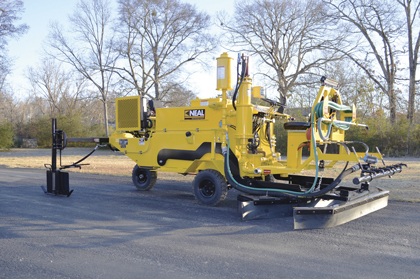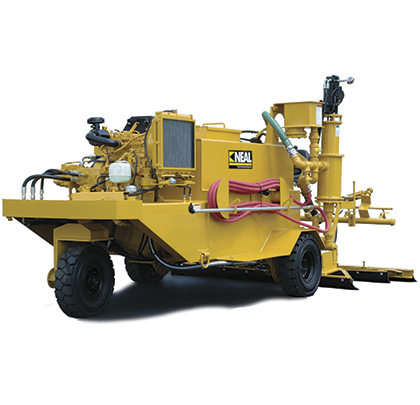Maximizing return on investment doesn’t take a mathematician. For sealcoat contractors, bringing in the most green comes down to selecting a machine that’s powerful, easy to maintain, and supported by a reliable manufacturer. Maximize ROI from sealcoating equipment by using these six points in the buying process.
SAY GOODBYE TO DAILY CLEANING
Reduce cleaning requirements and time by selecting a sealcoat machine with an easy-to-clean pump. Diaphragm pumps require daily rinsing to avoid the risk of sealcoat breaking down materials in the rubber. Skipping this step can reduce the pump’s life by 50 percent. Sealcoating machines with piston pumps only require rinsing out the pumps once a year before long-term storage. Comparing the 15 minutes of labor costs needed daily to clean a diaphragm pump to the annual cleaning a piston pump needs may average $25-$30 in labor every week, but that quickly adds up to more than $1,000 each year.
MINIMIZE MAINTENANCE
Like cleaning, contractors save time by choosing a machine that requires minimal maintenance. Not only that, but if the machine is properly maintained, it can last 20-30 years. Start by looking for pumps with few moving parts as well as leather seals, which require no daily maintenance and last nearly twice as long as rubber seals. Some pumps cost as much as $1,200 to repair or more than $2,000 to replace the gaskets and steel wear plates around the pump seals, which makes a big dent in the ROI. It’s important to ask questions about this ahead of time to avoid purchasing a machine that becomes a money pit.
Look for a machine with staggered agitators so only one or two agitator arms engage with the material at a time. Also, look for an agitation system with chain reduction to give the motor additional torque. On average, a chain reduction agitation system provides three times the power of a drive agitator.
Some manufacturers incorporate rubber wipers at the ends of the machine’s agitators to help scrape material off the walls inside the tank. While this initially seems like a beneficial feature, the rubber blades wear and tend to break off, causing rubber to get stuck in the pumping system, damaging it.
SAVE WITH STORAGE
A storage tank can cut long-term costs, too. With a tank, contractors have the ability to buy material in bulk, which generally reduces the price per gallon. Plus, storage tanks save transportation costs by reducing the trips to a sealcoat provider.
MAXIMIZE POWER
To quickly finish a job and get on to the next project, purchase a sealcoating machine with productive, powerful, and profitable components.
Start by considering the desired range of jobs. For the greatest flexibility from a single piece of equipment, look for a pump that pushes as much as 15 pounds of sand per gallon. This is ideal for covering large jobs, such as airports and parking lots, yet offers the versatility to take on smaller projects.
Having a built-in blower also affects power and productivity. While some contractors use walk-behind blowers to prepare the surface for sealcoating, a machine with a built-in blower eliminates the need for an additional piece of equipment. For the best results, look for a sealcoat machine with a blower that produces more than 6,000 cfm, which is triple the output of a typical walk-behind blower.
Efficiency can be taken a step further with a baffle attachment that automatically cuts-in sealcoat materials on the go while keeping curbs and edges free of material. When the attachment is paired with a built-in blower, contractors can perform sealcoat prep work as much as seven times faster than with traditional methods.
To take on additional projects, use a machine with a hydraulic agitation system instead of a manual agitation system. With a hydraulic system, operators eliminate the need to manually turn a crank to stir the sealcoat.
When it’s time to apply the sealcoat after cutting in, using a distributor bar is more efficient than a hand wand. Also, keep in mind that even when using a distributor bar, diaphragm pumps are less efficient than hydraulic pumps.

Featured Image: With a duel applicator sealcoat machine, such as the Neal DA250, a contractor reduces his or her competition for jobs because only five percent of contractors own these types of machines.
Above: A sealcoating baffle attachment automatically cuts-in sealcoat materials on the go while keeping curbs and edges free of material. When the attachment is paired with a built-in blower, contractors can perform sealcoat prep work as much as seven times faster than with traditional methods.
SET YOURSELF APART
Versatility is key when it comes to gaining a larger customer base. Unfortunately, some contractors find themselves limited by their application method—squeegee or spray. While both methods produce quality results, each are better at separate projects. For example, the squeegee method works well for rough surfaces that require packing material into the cracks and crevices, and the spray method works best on smooth surfaces.
For increased flexibility, consider a machine that offers both options. A sealcoat machine with a dual applicator system generally costs more than units with a single applicator. However, only about five percent of contractors own these types of machines, so competition for jobs is greatly reduced. Not only that, but the results last 40 percent longer than the two-coat industry-standard spray method.
WHO HAS YOUR BACK?
Having a quality sealcoat machine is half the battle when looking to maximize ROI. For taking profit potential further, work with a reliable, customer-focused manufacturer. That type of commitment will help keep equipment on the job. This means having personal diagnostic assistance available by phone to troubleshoot any problems as well as readily accessible parts for fast replacements. It’s also beneficial when manufacturers offer services for aging equipment, such as upgrades, parts replacements, or pump rebuilds, since it helps contractors get even more value from their existing equipment.
Selecting the right sealcoat machine from a reliable manufacturer sets contractors up for exceeding their ROI goals. Confidently take on projects with a machine that offers the necessary pumping capabilities and versatility. For a fast ROI, remember to look at all angles of the machine’s cost, from the initial investment to added labor and maintenance costs over time. With these tips in mind, raising ROI is a problem solved. ■
About the Author:
Maury Bagwell is the lead engineer at Neal Manufacturing, a division of Blastcrete, which is based in Anniston, Alabama. He has nearly 25 years of experience in manufacturing, sales, product design, and engineering. His primary responsibilities include product development, engineering, and quality control.
_________________________________________________________________________
Modern Contractor Solutions, July 2017
Did you enjoy this article?
Subscribe to the FREE Digital Edition of Modern Contractor Solutions magazine.

Raise Your Return


